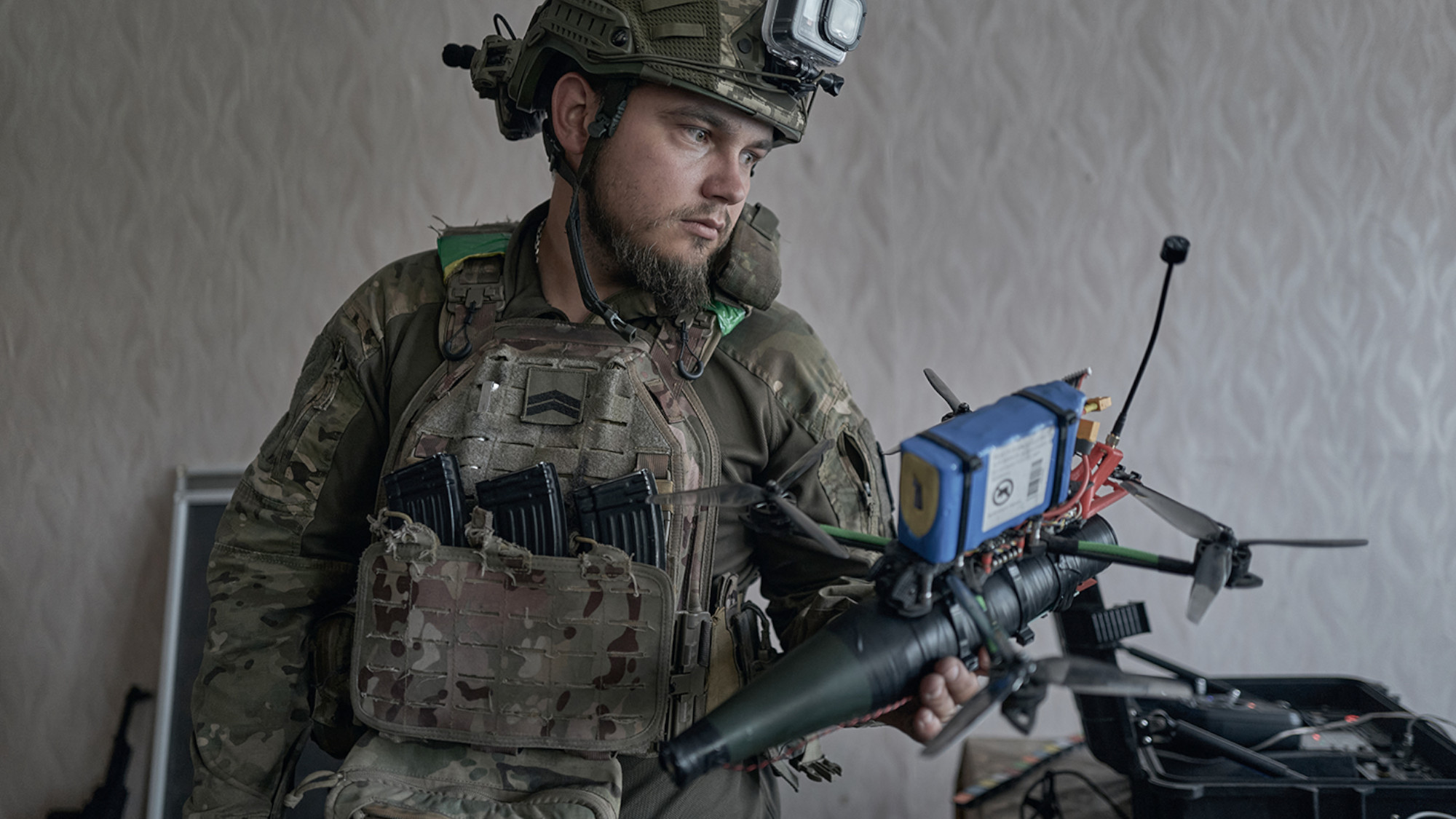Death from above: Drones upend rules of war in Ukraine
The world's militaries are paying close attention to drone use in the Russia-Ukraine war

How are drones used in the conflict?
Unmanned aerial vehicles (UAVs) have become the main weapon of the war in Ukraine—a bloody, high-tech clash that is seen as a harbinger of conflicts to come. While artillery battles once defined the war, up to 80% of all Russian and Ukrainian casualties are now caused by drone strikes. Ukraine's military claims that in May alone, its UAVs hit and destroyed 89,000 Russian targets, ranging from tanks to individual soldiers to fortified emplacements. And the technology is causing mayhem far beyond the front lines, with Ukraine using quadcopters (drones with four rotors) to mount a devastating June attack on airfields deep inside Russia, including one in eastern Siberia some 3,000 miles from Kyiv. Israel's surprise attack on Iranian nuclear facilities and military targets last month also relied heavily on UAVs. What's unfolding "is a systemic rupture in the conduct of modern warfare," say U.S. military analysts Antonio Salinas and Jason P. LeVay. They note that the old truisms of warcraft—that cover, concealment, courage, or even distance from the front can save a soldier—are being shredded. Small, low-cost drones can linger in the air for hours and then dive into trenches or sneak through the hatches of armored vehicles. All armed forces will have to adapt to this new reality, they argue, or risk "total defeat in war."
What kinds of drones have been deployed?
Some UAVs are fixed-wing aircraft that launch missiles—much like the U.S. Predators and Reapers deployed in Afghanistan and Iraq— or function like missiles by smashing into targets and exploding. The Russians have fired thousands of Iranian-designed, 11-foot-long Shahed drones into Ukraine, while the Ukrainians have built their own long-range drones that can attack targets over 700 miles away. But the real revolution is in smaller, battery-powered UAVs, with four to eight rotors. Many are first-person view (FPV), feeding video from an onboard camera to the operator's goggles or monitor in real time. These largely off-the-shelf radio-controlled models, which typically cost a few hundred dollars each, are used for reconnaissance, directing artillery attacks, and resupplying troops. They also can hover over an enemy position and drop a mortar shell, or be rigged with explosives and shrapnel to dive into a target kamikaze-style. "We call them celebration drones," said one Ukrainian commander. "They were used to film weddings and parties before the war."
Have UAVs changed the war?
They've made it deadlier. Some 400,000 Ukrainian troops and close to 1 million invading Russian soldiers have been killed or wounded since the war started in 2022, and Western analysts estimate that just under half of Russia's casualties occurred last year, largely because of the widening use of drones. Mechanized assaults are almost impossible in the drone age: a $400 drone can quickly take out a $2 million tank, and of the 31 M1A1 Abrams tanks the U.S. sent to Ukraine in 2023, all but four have been destroyed. The proliferation of eyes in the sky means soldiers must advance in small groups, on foot or on motorbikes. UAVs have also "gamified" the war: Under a Ukrainian program, pilots earn points for each video of a confirmed drone strike. Eliminating a tank gets eight points, a Russian drone pilot 25. Those points can then be traded in for more effective weapons, an incentive intended to direct equipment to the best units.
The Week
Escape your echo chamber. Get the facts behind the news, plus analysis from multiple perspectives.

Sign up for The Week's Free Newsletters
From our morning news briefing to a weekly Good News Newsletter, get the best of The Week delivered directly to your inbox.
From our morning news briefing to a weekly Good News Newsletter, get the best of The Week delivered directly to your inbox.
Can you defend against drones?
With difficulty. Soldiers have erected fishing nets over crucial supply routes to keep out UAVs and, less successfully, put steel grids known as "cope cages" on their tanks. Drones can be hit with interceptors, which can cost upwards of $1 million a shot. On the front line, soldiers carry shotguns, but they require quick reactions at perilously close range. The most successful defense so far has been electronic warfare: By the end of last year, both sides were knocking out roughly 75% of radio-controlled drones with signal jamming. In response, Russia started to use drones controlled by fiber-optic filament; the cable, spooled out as the drone flies, can stretch for up to 15 miles. That physical tether prevents jamming, and the lack of a radio signal makes it harder to identify a drone operator's location with a frequency detector. Fiber-optic drones were used to great effect to destroy Ukraine's supply lines into Russia's Kursk region, from which most Ukrainian forces were ejected in March; videos showed fields strewn with cables. "Everyone is trying to find countermeasures to fiber-optic drones," said a Ukrainian FPV instructor. "We don't have them, and neither do the Russians."
Which side is winning the drone war?
For a while, it seemed to be Ukraine. The country claims to have manufactured 2.2 million drones in 2024, and aims to produce 4.5 million in 2025. But Russia—with apparent help from China, the world's top manufacturer of fiber-optic cable and most drone parts—is catching up. Ukraine produces about 100 long-range drones a day; Russia makes 300. It's not yet clear which side will dominate the next stage of drone warfare. Both countries are testing swarm technology, in which packs of AI-guided drones work to surround and kill targets. Other countries, including the U.S., are following these advances closely and are rushing to develop their own drone and counter-drone technologies. "I hope no one in the world has to fight like this in the future," one Ukrainian commander said of the omnipresent terror of drones on the front line. "There is no place to rest, to think. It is hell."
Operation Spiderweb: A wake-up call
On June 1, Ukraine launched its most elaborate and audacious attack since the start of the war. Over 18 months, 117 FPV quadcopters were smuggled into Russia and hidden inside shipping containers with remote-controlled roofs. The containers were then loaded onto the backs of semitrucks, which parked near five air bases across Russia. With all the trucks in position, the roof panels of the containers simultaneously retracted and the drones took flight. According to U.S. officials, they hit up to 20 parked aircraft, including long-range bombers that have fired cruise missiles at Ukrainian cities, and destroyed about 10 of them. With a drone fleet that cost less than $1 million, Ukraine inflicted several billion dollars' worth of damage on Russia—and delivered a warning to the U.S. and its allies on their own vulnerabilities. Phillips Payson O'Brien, a professor of strategic studies at the University of St. Andrews in Scotland, notes that Chinese interests have for years been buying up American farmland close to U.S. military bases and national security installations. "They could be growing soybeans," said O'Brien, "but they could also be staging grounds for drone swarms that would make the Ukrainian attacks look minuscule."
A free daily email with the biggest news stories of the day – and the best features from TheWeek.com
-
 How to financially prepare for divorce
How to financially prepare for divorceThe Explainer Facing ‘irreconcilable differences’ does not have to be financially devastating
-
 Why it’s important to shop around for a mortgage and what to look for
Why it’s important to shop around for a mortgage and what to look forThe Explainer You can save big by comparing different mortgage offers
-
 4 ways to save on rising health care costs
4 ways to save on rising health care costsThe Explainer Health care expenses are part of an overall increase in the cost of living for Americans
-
 Vance’s ‘next move will reveal whether the conservative movement can move past Trump’
Vance’s ‘next move will reveal whether the conservative movement can move past Trump’Instant Opinion Opinion, comment and editorials of the day
-
 What have Trump’s Mar-a-Lago summits achieved?
What have Trump’s Mar-a-Lago summits achieved?Today’s big question Zelenskyy and Netanyahu meet the president in his Palm Beach ‘Winter White House’
-
 Donald Trump’s squeeze on Venezuela
Donald Trump’s squeeze on VenezuelaIn Depth The US president is relying on a ‘drip-drip pressure campaign’ to oust Maduro, tightening measures on oil, drugs and migration
-
 Trump vs. states: Who gets to regulate AI?
Trump vs. states: Who gets to regulate AI?Feature Trump launched a task force to challenge state laws on artificial intelligence, but regulation of the technology is under unclear jurisdiction
-
 Who is paying for Europe’s €90bn Ukraine loan?
Who is paying for Europe’s €90bn Ukraine loan?Today’s Big Question Kyiv secures crucial funding but the EU ‘blinked’ at the chance to strike a bold blow against Russia
-
 Pipe bombs: The end of a conspiracy theory?
Pipe bombs: The end of a conspiracy theory?Feature Despite Bongino and Bondi’s attempt at truth-telling, the MAGAverse is still convinced the Deep State is responsible
-
 Will there be peace before Christmas in Ukraine?
Will there be peace before Christmas in Ukraine?Today's Big Question Discussions over the weekend could see a unified set of proposals from EU, UK and US to present to Moscow
-
 Trump: Losing energy and support
Trump: Losing energy and supportFeature Polls show that only one of his major initiatives—securing the border—enjoys broad public support